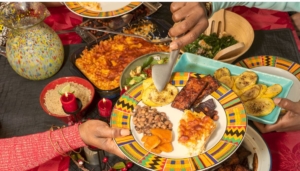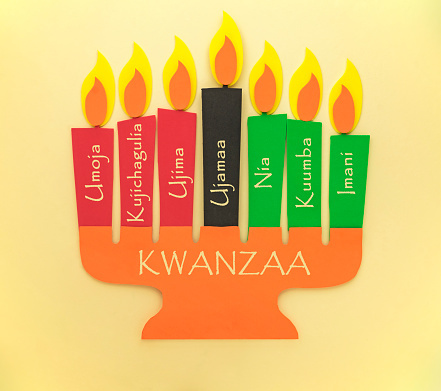 A Cultural Holiday
A Cultural Holiday
Source: Wikipedia, History.com
Kwanzaa (/ˈkwɑːn.zə/) is an annual celebration of African-American culture that is held from December 26th to January 1st, culminating in a communal feast called Karamu, usually held on the 6th day. Karamu Ya Imani (Feast of Faith) takes place on December 31st, the sixth day of the Kwanzaa period. The Karamu feast was developed in Chicago It was created by Maulana Karenga, based on African harvest festival traditions from various parts of Africa, including West and Southeast Africa. Kwanzaa was first celebrated in 1966.
-
Kwanzaa was created in the 1960s.
Maulana Karenga, a Black nationalist who later became a college professor, created Kwanzaa as a way of uniting and empowering the African American community in the aftermath of the deadly Watts Rebellion.
Having modeled his holiday on traditional African harvest festivals, he took the name “Kwanzaa” from the Swahili phrase, “matunda ya kwanza,” which means “first fruits.” The extra “a” was added, Karenga has said, simply to accommodate seven children at the first-ever Kwanzaa celebration in 1966, each of whom wanted to represent a letter.
-
Many people celebrate both Kwanzaa and Christmas.
Though often thought of as an alternative to Christmas, many people actually celebrate both. “Kwanzaa is not a religious holiday, but a cultural one with an inherent spiritual quality,” Karenga writes. “Thus, Africans of all faiths can and do celebrate Kwanzaa, i.e. Muslims, Christians, Black Hebrews, Jews, Buddhists, Baha’i and Hindus, as well as those who follow the ancient traditions of Maat, Yoruba, Ashanti, Dogon, etc.” According to Karenga, non-Black people can also enjoy Kwanzaa, just as non-Mexicans commemorate Cinco de Mayo, for example.
-
Kwanzaa centers around seven principles.
The seven principles of Kwanzaa, as determined by Karenga, are umoja (unity), kujichagulia (self-determination), ujima (collective work and responsibility), ujamaa (cooperative economics), nia (purpose), kuumba (creativity) and imani (faith). Kwanzaa also has seven symbols–mazao (crops), mkeka (mat), kinara (candleholder), muhindi (corn), kikombe cha umoja (unity cup), zawadi (gifts) and mishumaa saba (seven candles)–that are traditionally arranged on a table. Three of the seven candles are red, representing the struggle; three of the candles are green, representing the land and hope for the future; and one of the candles is black, representing people of African descent. Some families who celebrate Kwanzaa dress up or decorate their homes in those colors.
-
Homemade and educational gifts are encouraged.
In order to avoid over-commercialization, gifts handed out to family members on the last day of Kwanzaa are often homemade. Alternatively, some participants buy books, music, art accessories or other culturally themed products, preferably from a Black-owned business.
-
U.S. presidents habitually wish the nation a happy Kwanzaa.
Despite not observing the holiday, former president Barack Obama and his wife, Michelle, issued a statement in 2011 “to all those celebrating Kwanzaa.” “We know that there are still too many Americans going through enormous challenges and trying to make ends meet,” the president said. “But we also know that in the spirit of unity, or umoja, we can overcome those challenges together.” Presidents Bill Clinton and George W. Bush released similar statements during their time in office. The holiday also has made inroads with the U.S. Postal Service, which has issued Kwanzaa stamps since 1997.
The Feast of Faith, originally had families spent the night enjoying traditional African cuisine. Over the decades, celebrants have increasingly introduced food of the African diaspora to their feasts, such as Southern soul food and Caribbean dishes. The menu for the feast can vary depending on the family and their traditions, but no matter what, the table will likely include a few symbolic foods: the mazoa (fruits and vegetables symbolizing the bounty of the harvest) and the muhindi (ears of corn symbolizing fertility and representing each child in the family).
The main dish served at Karamu tends to be a one-pot stew, which can come from one of many traditions. Examples include everything from Ghanaian groundnut stew and Red red (African stewed black-eyed peas) to Cajun jambalaya and Creole gumbo. Meals usually include several starches as well, such as Virginia spoon bread, South African mealie bread, Southern Hoppin’ John, Nigerian jollof rice, Accras (Caribbean fritters), or Injera (Ethiopian flatbread). Other popular staples include catfish, jerk chicken, collard greens, fried plantains, fried okra, candied yams, sweet potato pie, and coconut pound cake, among several others.


Thank you so much for sharing information on Kwanzaa. I have been celebrating for years and love seeing it grow through our youth. We need this.